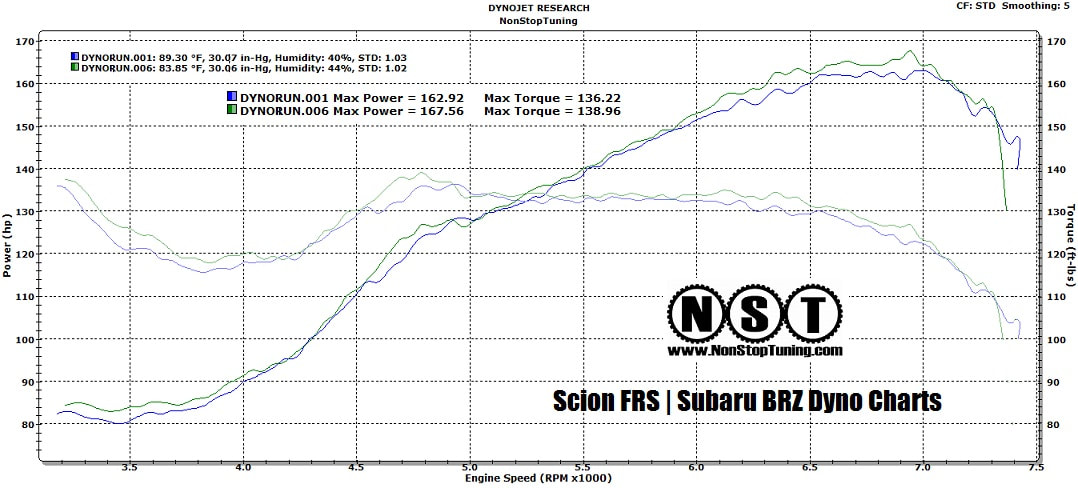We’ve all heard it before, “Do lightweight aluminum pulleys free horsepower? Do they make your car faster? Are they really worth it?” At NonStopTuning we’ve been designing and testing pulley kits of various types for more than 15 years and have posted our results on various outlets. We’ve consolidated these results into one post, with several links, for your review.
Why are NonStopTuning pulleys a popular choice for many of our customers?
Crank pulleys, attached to the outside of the crankshaft, are the source of power for a car’s accessories. The alternator, power steering, water pump, and air conditioner are all belt driven units, attached to the crank pulley, that use horsepower from an engine to provide their own services. Underdrive pulley systems increase an engine’s horsepower by reducing the power required to drive the external engine accessories. By replacing factory pulleys with carefully resized units, the accessories are slowed enough so that their performance does not suffer, but just enough so that more horsepower is sent to the wheels and put to the ground, where horsepower should be.
NST pulleys often increase engine output by 7 to 12 horsepower, with even better power levels yielded from turbo models than seen in naturally aspirated engines. This increase results in quarter-mile time and road course lap improvements, easily making this one of the best “bang for your buck” modifications.
Another great benefit in replacing factory pulleys with NST units is reduced weight. Factory units, also referred to as OEM, are generally constructed from steel or cast iron. NST pulleys are CNC machined from aircraft quality aluminum, making them extremely durable while at the same time much lighter than their OEM counterparts. This weight reduction (approximately 70%) results in less rotating mass on the engine’s crankshaft which drastically increases the engine’s ability to rev to speed faster.
Better throttle response, better horsepower and torque delivery, and better fuel economy can all be had when using NST pulleys.
Crank pulleys, attached to the outside of the crankshaft, are the source of power for a car’s accessories. The alternator, power steering, water pump, and air conditioner are all belt driven units, attached to the crank pulley, that use horsepower from an engine to provide their own services. Underdrive pulley systems increase an engine’s horsepower by reducing the power required to drive the external engine accessories. By replacing factory pulleys with carefully resized units, the accessories are slowed enough so that their performance does not suffer, but just enough so that more horsepower is sent to the wheels and put to the ground, where horsepower should be.
NST pulleys often increase engine output by 7 to 12 horsepower, with even better power levels yielded from turbo models than seen in naturally aspirated engines. This increase results in quarter-mile time and road course lap improvements, easily making this one of the best “bang for your buck” modifications.
Another great benefit in replacing factory pulleys with NST units is reduced weight. Factory units, also referred to as OEM, are generally constructed from steel or cast iron. NST pulleys are CNC machined from aircraft quality aluminum, making them extremely durable while at the same time much lighter than their OEM counterparts. This weight reduction (approximately 70%) results in less rotating mass on the engine’s crankshaft which drastically increases the engine’s ability to rev to speed faster.
Better throttle response, better horsepower and torque delivery, and better fuel economy can all be had when using NST pulleys.
DYNO TESTING AND LINKS TO DATA
All dyno testing performed by third party installers and dyno operators. Baselines and pulley dynos all performed on the same dyno, on the same day, with no other modifications. All test cars were “bone stock” models; no change in tune, timing, etc.
All dyno testing performed by third party installers and dyno operators. Baselines and pulley dynos all performed on the same dyno, on the same day, with no other modifications. All test cars were “bone stock” models; no change in tune, timing, etc.
Conclusion? In a nutshell, YES, lightweight aluminum pulleys do free power and torque.
The dyno charts consistently prove that lightweight pulleys improve power, torque, and response across the entire power band. If you look at the area under the power and torque curves you will notice positive gains in the low, mid, and high range when an NST Pulley Kit is used. No other modification in the same price range can offer similar gains across the entire power band.
The dyno charts consistently prove that lightweight pulleys improve power, torque, and response across the entire power band. If you look at the area under the power and torque curves you will notice positive gains in the low, mid, and high range when an NST Pulley Kit is used. No other modification in the same price range can offer similar gains across the entire power band.









